Chapter 10: Work and Mechanical Energy

Equations Introduced and Used for for this Topic (all equations are solved as either scalar or vector):
[latex]Work(W) =\overrightarrow{F}_{net} •\overrightarrow{d} or \overrightarrow{F}_{net}\overrightarrow{d} cos Ø[/latex] W = ∆ Mechanical Energy
Ep = mgh ∆Ep = mg∆h Ek = ½mv2 ∆Ek = ½m∆v2
∆h = hf – hi ∆v = vf – vi V or Vg = gh
w = m g
Where
W is Work, measured in Joules (J)
Ep or ∆Ep is Gravitational Potential Energy or change in Gravitational Potential Energy, measured in Joules (J)
Ek or ∆Ek is Kinetic Energy or change in Kinetic Energy, measured in Joules (J)
E or ∆E is Energy or change in Energy, measured in Joules (J)
V or Vg is the Gravitational Potential, measured in Newtons per Kilogram (N/kg)
m is the Mass of the object, measured in Kilograms (kg)
g or ag is the Gravitational Field Strength, measured in Metres per Second squared (m/s2)
v is the Speed of the object, measured in Metres per Second (m/s)
v or ∆v is the Speed or change in Speed of the object, measured in Metres per Second (m/s)
vf & vi is the final and initial Speed of the object, measured in Metres per Second (m/s)
Fnet is the Net Force or the Vector Sum of the Forces acting on a body or a system, measured in Newtons (N)
ø is the angle between the vectors of the Net Force and Displacement, measured in degrees (°)
d is the displacement through which the Net Force acts on a body or a System, measured in Metres (m)
h or ∆h is the height or change in Vertical Height, measured in Metres (m)
hf & hi is the final and initial height of the object measured in Metres (m)
Notes:
The Dot Product “ • “ represents the cosine of the angle between two vectors. For Work it represents the angle between the direction of the Net Force and the displacement change.
The Cross Product “x “ represents the sine of the angle between two vectors. Equations using the cross product will be given later in your study of physics, such as the measure of Torque or the force on a charged particle moving in a magnetic field.
Work and Energy are measured in Joules (J) or Newton-Metres (Nm)
For Example: Consider the following multiplication of these two vectors shown below.
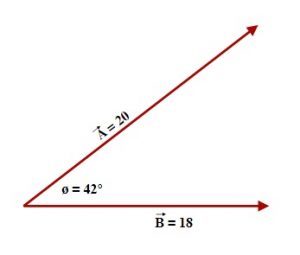
[latex]\overrightarrow{A}•\overrightarrow{B} =\overrightarrow{A}\overrightarrow{B}[/latex] cos ø
[latex]\overrightarrow{A}•\overrightarrow{B}[/latex]= (20)(18) cos 42º
[latex]\overrightarrow{A}•\overrightarrow{B}[/latex]= 267.5 or 270
[latex]\overrightarrow{A}\times\overrightarrow{B}=\overrightarrow{A}\overrightarrow{B}[/latex] sin º
[latex]\overrightarrow{A}\times\overrightarrow{B}[/latex]= (20(18) sin 42º
[latex]\overrightarrow{A}\times\overrightarrow{B}[/latex]= 240.9 or 240
The Dot Product for these two vectors is:
[latex]\overrightarrow{A}•\overrightarrow{B}=\overrightarrow{A}\overrightarrow{B}[/latex] cos Ø
[latex]\overrightarrow{A}•\overrightarrow{B}[/latex]= (20(18) cos 42º
[latex]\overrightarrow{A}•\overrightarrow{B}[/latex]= 267.5 or 270
The Cross Product for these two vectors is …
[latex]\overrightarrow{A}\times\overrightarrow{B}= \overrightarrow{A}\overrightarrow{B}[/latex]= sin Ø
[latex]\overrightarrow{A}\times\overrightarrow{B}[/latex]= (20(18) sin 42º
[latex]\overrightarrow{A}\times\overrightarrow{B}[/latex]= 240.9 or 240
10.1 Kinetic and Potential Energy5, 6
Equations Introduced and Used in this Topic:
Ep = mgh ∆Ep = mg∆h Ek = ½ mv2 ∆Ek = ½ m∆v2
∆h = hf – hi ∆v = vf – vi V or Vg = gh
Conceptual Development:
The concept of energy is generally credited to Aristotle’s (384 BC-322 BC) enérgeia (ἐνέργειά), which is a word having no direct translation into English except for “being at work”. Aristotle’s concept of work grew from Empedocles’s (490-430 BC) thoughts on the basic elements of all matter: earth, water, air, fire and quintessence, with fire being characterized as the driver behind his thoughts and understanding leading to the concept of enérgeia. Aristotle’s concepts remained in vogue for nearly two thousand years before The Age of Enlightenment in European science began to take prominence in creating a new paradigm to understand energy.
The first of these developments was in 1669 by Christian Huygens (1629 -1695), who recognized that in a specific collision between two hardwood spheres (close to an elastic collision) the product of mass times the square of the speed7 was conserved along with what became known as momentum. This discovery is credited as the origin of the modern concepts of mechanical energy, specifically kinetic energy. Huygens’s name for his discovery was not energy but vis viva (living force)8. A couple of decades later, Gottfried Wilhelm von Leibniz (1646-1716) in 1686 became the first to quantify the concept of vis-viva as the product of mass times the square of the speed.
Thomas Young (1773-1829) introduced the word “energy” in 1800 but it did not enter common usage at that time. Instead the name “energy” was popularized around fifty years later by William Thomson, Lord Kelvin (1824 – 1907) and William J. M. Rankine (1820-1872) as the concept of force was integrated to act across other related phenomena.
When one looks back at the explosion of European physics that occurred in The Age of Enlightenment, and following Leibniz’s vis viva, the concepts linking force and energy, heat 9 and work all helped to lay the foundations for a complete overhaul of the understanding of science in its Greek origins some two thousand years prior. Eventually these developments led to Albert Einstein’s (1879-1955) rewriting of the Newtonian mechanical universe and arguably the most famous equation in physics equating the relationship between matter and energy:
E = mc2
Modern use of the word “energy” generally causes much confusion about the concepts of energy in introductory physics classes. The next few sections in this chapter will outline a physical definition of the energy concepts (scalar measures) and how to quantify energy in modern SI metric measures.
Two energy forms, termed “kinetic energy” and “potential energy”, are both classified as forms of mechanical energy.
The first of these, Kinetic Energy10, is the measure of the energy held by a body in motion. The measure of an object’s kinetic energy is almost identical to that of the vis viva proposed by Leibniz (mv2) except that it is 1/2 the measure. Energy is often denoted by the capital letter E with a subscript of k to denote that it is the kinetic energy form (Ek)11.
In Newtonian mechanics, the measure of a body’s kinetic energy is represented by the equation:
Ek = ½ mv2
where the mass of the moving object is given in kilograms (kg) and the speed of the object is given in metres per second (m/s). The measure of energy is given the name Joules (J) in honor of James Prescott Joule (1818 – 1889) for his work in his discovery of the mechanical equivalent of heat, which later led to the law of conservation of energy and the development of the First Law of Thermodynamics.
Kinetic Energy can simply be remembered as the energy of a moving body.
The second of the mechanical energies is termed Gravitational Potential Energy (Ep) or its shortened version, Potential Energy12, 13, which is the energy of any object where gravity can accelerate an object through a vertical displacement, meaning that the change in position of an object is central. Common examples of gravitational potential energy can be seen in roller coasters, water wheels, and in the dams used to create hydroelectric power.
In Newtonian mechanics the measure of a body’s potential energy is given by the equation:
∆ Ep = mg∆h or Ep = mgh
where the mass of the object is given in kilograms (kg), gravity is the strength of gravity for this position measured in metres per second squared (m/s2) and the change in position or height is measured in metres (m). As in kinetic energy, this textbook uses the symbol E to designate energy and the subscript p to indicate that it is potential energy (Ep)14. The units of measure are the same as those used in kinetic energy, Joules (J).
Potential Energy can simply be remembered as the energy of a body that can move under the influence of gravity, accelerating it.
Gravitational Potential or Gravitational Potential Difference15 is a concept shared with electricity. You will run into two variations of it in both gravitational and electrical situations. In this first case we only deal with a constant strength gravitational field. Gravitational potential and Electrical potential both use the same symbol (V), named in honor of Alessandro Volta.
Quite simply, gravitational potential in a constant strength gravitational field represents the product of the strength of gravity and change in height. Or: V = gh. If you wish you can use Vgto represent gravitational potential andVel to represent Electrical potential but these are non-standard notations.
You should note that Gravitational Potential V (aka: gravitational potential difference) is close in concept to that of Gravitational Potential EnergyEp, with the only difference being that to find the potential energy involved, we must use the mass that is being moved through the potential difference. In this way, in a constant gravitational field, Ep = mV or mgh, the Units for Gravitational Potential are Joules/kilogram (J/kg).
EXAMPLE 10.1.1
What is the average gravitational potential of Niagara Falls, having an average height change before hitting the rocks (hidden by the falls) 53.4 m below?

V = find
Δh = 53.4 m
g = 9.8 m/s2 V = gΔh
V = (9.8 m/s2)(53.4 m)
V = 523 J/kg
(≈ 520 J/kg)
The change in Potential Energy (∆Ep) can be calculated using gravitational potential if you have the amount of mass that is moving through the potential difference. You will be using the potential difference concept in much greater detail in the later topics concerning electricity.
The following examples illustrate the equations using the potential and kinetic energy equations.
EXAMPLE 10.1.2
What is the kinetic energy of a 1250 kg car moving at 90 km/h?
Ek = ½ mv2
Ek = ½ (1250 kg)(25 m/s)2
Ek = 391 000 J ( ≈ 390 000 J)
EXAMPLE 10.1.3
Fifty tonnes of water fall from a height of 3.0 m. What is the change in potential energy for this water?
∆Ep = mg∆h
∆Ep = (50 000 kg)(9.8 m/s2)(3.0 m)
∆Ep = 1 470 000 J or 1.47 MJ
EXAMPLE 10.1.4
A 0.500 gram meteor has a momentum of 7.50 Ns. What is its kinetic energy?
First, find the speed of the meteor:
p = mv (no vector signs are needed since no direction is given)
7.50 Ns = (0.5 x 10-3 kg) v
v = 7.50 Ns ÷ 0.5 x 10-3 kg
v = 15 000 m/s
Second, find its kinetic energy
Ek = ½ mv2
Ek = ½ (0.5 x 10-3 kg)(15 000 m/s)2
Ek = 56 250 J (≈ 56 000 J)
EXAMPLE 10.1.5
A 7.5 kg mass dropped from a 50 m high bridge changed its velocity from 0 m/s to – 31.3 m/s before striking the ground below. Calculate:
(i) The change in momentum
[latex]\overrightarrow{p} = m\Delta\overrightarrow{v}\textit{or m}(\overrightarrow{v}_{f} -\overrightarrow{v}_{i})[/latex]
[latex]\Delta\overrightarrow{p}\text{= (7.5 kg)(-31 m/s - 0 m/s)}[/latex]
[latex]\Delta\overrightarrow{p}\text{= - 235 Ns}[/latex]
(ii) The change in kinetic energy
∆ Ek = Ekf – Eki
∆ Ek = ½ (7.5 kg)(31.3 m/s)2 – 0 J
∆ Ek = 3674 J (≈ 3700 J)
(iii) The change in potential energy
∆ Ep = Epf – Epi
∆ Ep = 0 J – (7.5 kg)(9.8 m/s2)(50 m)
∆ Ep = – 3674 J (≈ – 3700 J)
QUESTIONS 10.2 Kinetic and Potential Energy
1. What is the kinetic energy of a 50 kg mass moving at 10 m/s?
2. A 1.0 tonne mass is raised to a height of 3.0 m. What is its change in potential energy?
3. What is the kinetic energy of an electron (mass 9.11 x 10-31 kg) when it is moving at a speed of 1.0 x 107 m/s?
4. A 7.5 kg mass has its velocity changed from 15 m/s North to 20 m/s North. Calculate:(i) the change in momentum; (ii) the change in kinetic energy.
5. A 10 gram meteor has a momentum of 7.5 Ns. What is its kinetic energy?
6. A child drops 4 identical marbles (0.015 kg) once each second until they are all dropped. After the first marble has fallen for 6.0 s what is the difference in the kinetic energy between the first and the last dropped? (hint: draw a sketch of this)
10.2 Work 16
Equations used:
[latex]\text{Work (W)}=\overrightarrow{F}_{net}\bullet\overrightarrow{d}\text{or}\overrightarrow{F}_{net}\overrightarrow{d}\text{cos Ø}[/latex] w = mg
Conceptual Development:
The concept of work is largely accepted as having been introduced by Gaspard-Gustave de Coriolis (1792 – 1843), who believed that work resulted in a transfer of energy by lifting a weight over a distance. These thoughts are believed to have originated from the early use of steam engines used to lift buckets of water out of flooded mines. As such, work was originally defined as the transfer of energy from one place to another or from one form to another. A simple definition of Coriolis’s concept looks like:
W = ∆ Energy (or W = ∆Ep)
where energy can be given or extracted from a system by doing work on it. The units of work are Joules (J). Often the units Newton-metre (Nm) are used as a measure of work but recent movements by academic organizations are acting to discourage this unit due to possible confusion with the concept of Torque, that uses Nm as its measure.
When one looks at the concept of lifting a weight to a height, one is able to define the measure of work using algebra. Specifically: W = Fnet d where the net force must be in a direction to change the height of the object.
This means that the Force used must be in the same direction or in the opposite direction to the change in displacement of the object. The angle between the Force vector and the displacement vector must be either 0° or 180°. The equation of W = F d is corrected by the addition of the cosine function of the angle between the force vector and the displacement vector. Specifically:
W = Fnet d cos ø or W = Fnet • d
Consider the work done in changing the potential energy of the following tubs of water:
Example 10.2.1
Find the work done changing Ep of a 20 kg tub of water for the following:
a. Force upwards balances the weight b. Force upwards moves the bucket up 2.0 m and stops
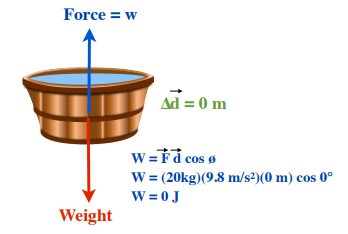
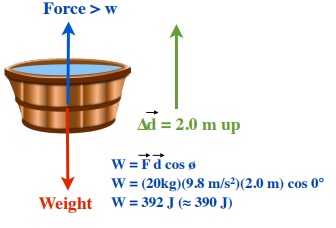
c. Force moves the bucket 2.0 m at an angle d. Force moves the bucket 2.0 m
of 42º upwards and stops to the side and stops
Force = w & angled to the right Force = w & to the right
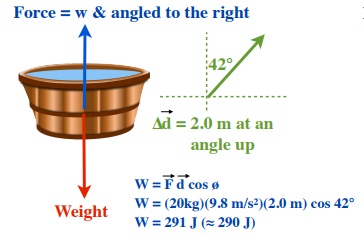
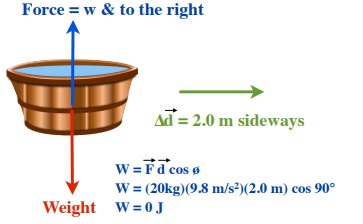
e. Force moves the bucket 2.0 m at an f. Force lowers the bucket 2.0 m
angle down Force = w & angled to the right
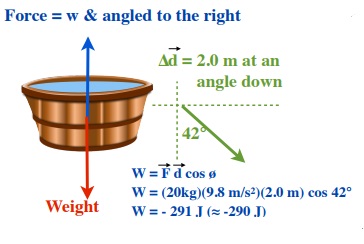

EXAMPLE 10.2.2
Find the work done when:
(i) A force of 10.0 N acts over a distance of 2.0 m
W = F d cos ø
W = (10 N)(2.0 m) cos 0°
W = 20 J
(ii) A force of 12 µN acts over a distance of 0.55 mm
W = F d cos ø
W = (12 x 10-6 N)(0.55 x 10-3 m) cos 0°
W = 6.6 x 10-9 J
(iii) A mover lifts a 480 N box of books to a vertical displacement of 5.0 m
W = F d cos ø
W = (480 N)(5.0 m) cos 0°
W = 2400 J
(iv) 50 kg of water is raised from a well 20 m deep
W = F d cos ø
W = (50 kg)(9.8 m/s2)(20 m) cos 0°
W = 9800 J
(v) A stove is slid 2.0 m across a floor against an average resistance of 420 N
W = F d cos ø
W = (420 N)(2.0 m) cos 0°
W = 840 J
EXAMPLE 10.2.3
What displacement does a net force of 42 N East need to act over to do 240 J of work?
W =[latex]\overrightarrow{F}\overrightarrow{d}[/latex] cos Ø
240 J = (42 N East)[latex](\overrightarrow{d})[/latex] cos 0°
[latex]\overrightarrow{d}[/latex] = 240 J ÷ 42 N East
[latex]\overrightarrow{d}[/latex] = 5.71 m East
EXAMPLE 10.2.4
How much work is done by a net force that resulted in a 20.0 kg mass accelerating at 0.50 m/s2 over a distance of 12 m?
W = F d cos ø
W = (20.0 kg)(0.50 m/s2)(12 m) cos 0°
W = 120 J
QUESTIONS 10.3 Work
Find the work done when:
(i) A force of 8.0 N acts over a distance of 2.0 m
(ii) A force of 12 N acts over a distance of 55 cm
(iii) A bricklayer lifts a brick weighing 25 N up a vertical displacement of 1.8 m
(iv) 1015 kg of coal is raised from the bottom of a mine 310 m deep
(v) A box is pushed 10.0 m across a floor with average speed against a 42.0 N resistance
2. A force of 17 N South performed 136 J of work. What displacement did the force act over?
3. How much work is done by a force of 105 N (as shown below) if it acts at right angles to the direction this car is moving?

4. A girl on a bicycle drags a wagon full of a newspapers at 0.80 m/s for 30 minutes requiring a constant force of 40 N. What amount of work has this child done?
5. How much work is done by a force which results in a mass of 30.0 kg having an acceleration of 1.50 m/s2 over a distance of 700 cm?
10.3 Work & Mechanical Energy 17, 18, 19, 20
Equations Used in this Section:
Work (W) =[latex]\overrightarrow{F}_{net}•\overrightarrow{d} or\overrightarrow{F}_{net}\overrightarrow{d}[/latex] cos Ø W = ∆ Mechanical Energy
Ep = mgh ∆Ep = mg∆h Ek = ½mv2 ∆Ek = ½m∆v2
∆Ep = mg(hf – hi) ∆Ek = ½m∆ (vf2– vi2)
∆h = hf – hi ∆v = vf – vi V or Vg = gh
Summarizing the previous section:
• If the net force is in the same direction as the displacement, then the system gains energy.
• If the net force is in the opposite direction to the displacement, then energy is removed from the system.
• If the net force direction is at 90° to the change in displacement, then there is no change in the energy of the system.
In this section we investigate the relationship between work and the change in the mechanical energy of a system using W = ∆ Mechanical Energy. Using this restriction, we will only be considering changes to potential energy (∆Ep = mgh) and kinetic energy (∆Ek = ½ mv2). As before, the force used to change the energy of an object is the net force (and must be conservative) acting on the object which results in a change in the object’s displacement, specifically:
[latex][Work (W) =\overrightarrow{F}_{net}•\overrightarrow{d} or\overrightarrow{F}_{net}\overrightarrow{d}\text{cos Ø}][/latex]
Net conservative forces21 are used to define work that acts to change the energy of a body or a system.
The easiest work energy relationship to work with comes from the Work-Energy Theorem, where the work done can be defined by the resulting change in an object’s kinetic energy. Specifically:
W = ∆ Ek or Ekf – Eki
In this case all one needs to do is to find the change in kinetic energy to calculate the work done.
Expanding one [Work (W) =[latex]\overrightarrow{F}_{net}•\overrightarrow{d} or\overrightarrow{F}_{net}\overrightarrow{d}[/latex] cos Ø}] one gets to extend the quantification of force to be either accelerating or braking, and if it is acting at a vertical angle to the change in the object’s displacement.
It is more complicated to define work as a change in potential energy, since one is restricted to the change in vertical height to calculate this change. For instance, if an object is raised and lowered several times but ends up in the initial position at the end of this event, then ∆Ep = 0 Jeven though a lot of energy was expended in raising and lowering the object. Changes in potential energy are path dependent.
For the W = ∆ Ek to be used correctly in these problems, the force acting must be a conservative force, where the only changes in energy are potential and kinetic. As you advance in your physics studies, you will be required to distinguish between conservative forces and non-conservative forces.
The derivation of the kinetic energy equation can be completed using an equation termed the work-energy theorem, specifically W = ∆ Ek and the angle between the force and displacement ø = 0°.
First: [latex]W =\Delta\text{Energy where W}\overrightarrow{F}_{net}•\overrightarrow{d}\&\overrightarrow{F}_{net}[/latex]= ma(d)
Yielding: ∆ Energy = mad
Using the kinematic equation: 2ad = vf2 – vi2
ad =[latex]\dfrac{(v_{f}^{2}-v_{i}^{2})}{2}[/latex]
Substituting into the first equation ∆ Energy = mad, we get:
[latex]\Delta E =\dfrac{v_{f}^{2} - v_{i}^{2}}{2}[/latex]
And is generally written as: Ek = ½mv2
The derivation of potential energy has two versions: one for a constant gravitational field strength and the second (which is covered later) for a variable gravitational field where there is a change in gravity as one moves away (or towards) a planet, sun or moon.
The derivation of the potential energy equation can also be done using the work-energy theorem., specifically ∆ Energy = W or (Fnet d cos ø or magd) and requires that the acceleration of gravity affecting the body is constant and the angle between the net force and the change in vertical displacement is ø = 0°. This derivation is easily completed.
First: W = ∆ Energy where W = Fnet • d & Fnet = ma(d)
Yielding: ∆ Energy = mad
Replace a with the constant acceleration due to gravity and d with the vertical change in height.
This results in ∆ Energy = mg∆h
And is generally written as Ep = mgh
EXAMPLE 10.3.1
How much work is done by an electric pump which raises 200 kg of water for irrigation for a vertical distance of 150 m?
W = ∆ Ep
W = (200 kg)(9.8 m/s2)(150 m) cos 0°
W = 294 000 J (≈ 290 000 J)
EXAMPLE 10.3.2
How much work is done in raising a 1500 kg pile driver for a potential difference of 400 N/kg?
Note: Potential difference (V) represents the product of gh
W = ∆ Ep where ∆ Ep = mgh or mV
W = (1500 kg)(400 N/kg) cos 0°
W = 600 000 J
EXAMPLE 10.3.3
For what distance must a 4.00 tonne pile driver fall to do 500 kJ of work?
W = ∆ Ep
500 kJ = (4000 kg)(9.8 m/s2) d cos 0°
d = (500 000 J ÷ 39 200 kg m/s2)
d = 12.8 m (≈ 13 m)
EXAMPLE 10.3.4
At what speed must a 400 kg pile driver be falling to do 15 000 J of work?
W = ∆Ek
15 000 J = ½ (400 kg)v2
v2 = 15 000 J ÷ 200 kg
v = 8.66 m/s (≈ 8.7 m/s)
EXAMPLE 10.3.5
How much work is needed to stop a truck that has 400 kJ of kinetic energy in 10 s in a distance of 50 m?
Since work = Energy and the truck has 400 kJ of kinetic Energy, the work done is:
W = Ekf – Eki
W = 0 J – 400 kJ = – 400 000 J
The minus sign means that 400 000 J of energy was extracted from the truck.
EXAMPLE 10.3.6
A semi-truck has 4.0 MJ of kinetic energy. What braking force would bring it to a full stop in a distance of 500 m?
First the work done is extracting 4.0 MJ energy from the truck, therefore
W = F d cos ø
– 4.0 MJ = F (500 m) cos 0°
F = – 4 000 000 J ÷ 500 m or – 8000 N
EXAMPLE 10.3.7
A commercial jet (mass 80 000 kg) lands on a horizontal runway at 165 km/h. If it decelerates through a displacement of 1200 m before coming to a full stop, calculate the average net force exerted by its brakes.
First: W = ∆ Energy, where the change in energy is the kinetic energy of the jet.
Therefore: W = ∆ Ek (or Ekf – Eki) where Ekf = 0 J
Expanded, this equals F d cos ø = 0 J – ½ mv2
F (1200 m) cos 0° = – ½ (80 000 kg)(45.8 m/s)2
F = – 70 000 N
The negative in the solution for 9.36 and 9.37 means that energy is being extracted from the system or that negative work is being done on these systems.
QUESTIONS 10.4 Work and Mechanical Energy
1. A 50.0 g cannon shell is traveling at 700 m/s at a height of 2.5 km. Calculate its:
(i) Kinetic Energy
(ii) Potential Energy
(iii) Total Mechanical Energy
2. How much work is done by a pump which raises 2.00 metric tonnes of water for a vertical distance of 50.0 m?
3. How much work is done in raising 100.0 kg for a potential difference of 196 N/kg?
4. For what potential difference must a 400 kg pile driver fall to do 15 000 J of work?
5. How much work is needed for a 100 kg person to reach a speed of 10 m/s from rest?
6. How much work is needed to stop a 1400 kg truck traveling at 100 km/h?
7. What average braking force is required to stop a 2 tonne truck traveling at 80 km/h in 200 m?
8. A 60 kg softball player slides into home plate going from 9.5 m/s to a full stop in 2.5 m. What average force acts on this player?
9. How much work is needed to slow a 5.8 kg mass from a speed of 2.3 m/s to 1.5 m/s?
10. A bullet (mass 1.75 g) is fired at 125 m/s into a thick block of wood where it comes to rest. How much work did this bullet do on the block of wood?
11. An 80.0 g mass is fired at a wall with a horizontal velocity of 130 m/s and emerges at 65 m/s. How much work was done in piercing this wall?
12. An airplane (mass 2400 kg) lands on a horizontal runway at 50 m/s. If it decelerates through a displacement of 180 m before coming to a full stop, calculate the average force exerted by these brakes.
13. A truck has 200 KJ of kinetic energy. What braking force would bring it to a full stop in a distance of 250 m?
14. A 2.0 g bullet is shot into a tree stump. It enters at a speed of 300 m/s and comes to rest after penetrating 5.0 cm in a straight line. What was the average force acting on this bullet during the impact and how much work did this bullet do?
15. A truck of mass 2.0 tonnes is moving at 20 m/s. Calculate: (i) its kinetic energy; (ii) the force needed to stop it in 10 s; (iii) the force needed to stop it in 100 m.
16. A 1200 kg car is traveling at 25 m/s at the top of a 60 m high hill before it starts to descend. At the base of the hill the brakes are applied with an average force of 8000 N. What distance is required to bring this car to a full stop?
QUESTIONS 10.4.1 The Ballistic Pendulum
The Ballistic Pendulum was invented in 1742 by English mathematician Benjamin Robins (1707–1751) and published in his book New Principles of Gunnery which revolutionized the science of ballistics, since it provided the first way to accurately measure the velocity of a bullet. Robins used the ballistic pendulum to measure projectile velocity in two ways. The first was to attach the gun to the pendulum and measure the recoil. Since the momentum of the gun is equal to the momentum of the ejecta and since the projectile was (in those experiments) the large majority of the mass of the ejecta, the velocity of the bullet could be approximated. The second and more accurate method was to directly measure the bullet momentum by firing it into the pendulum and measuring the change in potential energy of the pendulum + embedded bullet.
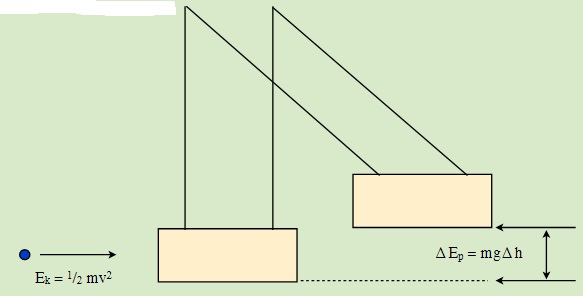
Question: Suppose one wanted to set up a ballistics pendulum to check the muzzle velocity of a bullet fired from an 1894 Winchester (30-30) as shown below. Specs show that it should shoot an 8 g (130 grain) bullet at 759 m/s. What mass of wooden block would be needed so that it would rise 10.0 cm above its rest position after being struck by this bullet?

QUESTIONS 10.4.2 Bennu on JPL’s Sentry
Bennu on JPL’s Sentry: Earth Monitoring List. NASA has a program that monitors the orbits of Near-Earth Objects (NEOs) as part of its support of NASA’s Planetary Defense Coordination Office. NEO objects (mainly asteroids) are analyzed and classified according to their orbital parameters, close approaches to Earth, and impact risks, along with other factors that record their discovery and possible missions to travel to. Sentry is a special list of potentially hazardous NEOs that pose a threat from possible impact with the Earth. Considered to be the most dangerous are the asteroids 29075 1950DA, which has a diameter of 2000 m, with a 1/8300 chance of impact in 2880-03-16, 410777 2009FD, which has a diameter of 150 m, with a 1/710 chance of impact in 2185-03-29, and 101955 Bennu, which has a diameter of 484 m, with a 1/2700 chance of impact between 2175 and 2199. Of these three, 29074 1950DA is considered to be the greatest risk to Earth and 101955 Bennu to be of the second greatest known risk.
101955 Bennu or simply Bennu (named after the Egyptian mythological bird Bennu) has an average diameter of close to 1/2 km (492 m) orbits the Sun every 1.20 yr (436.65 d), traveling an average 12.1 km/s. It has an estimated mass of 7.329 ± 0.009 x 1010 kg with an average density of 1.26 ± 0.013 x 103 kg/m3 indicating a density that is slightly larger than water. Close analysis indicate Bennu to be basically a big ball of rubble varying in size from mm up to one observed 20 m boulder. However, the energy released of an impact with the Earth is estimated to be in the range of 1200 megatons on TNT (roughly 80 000 times that of the nuclear weapon dropped on Hiroshima in World War II).

REFERENCES:

